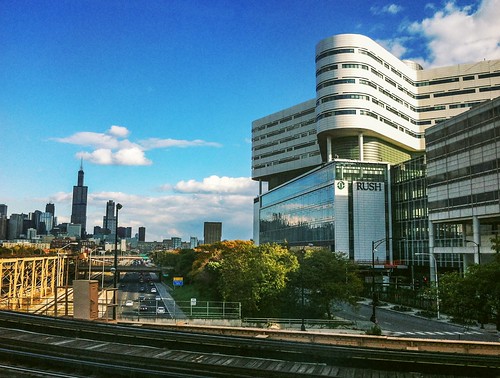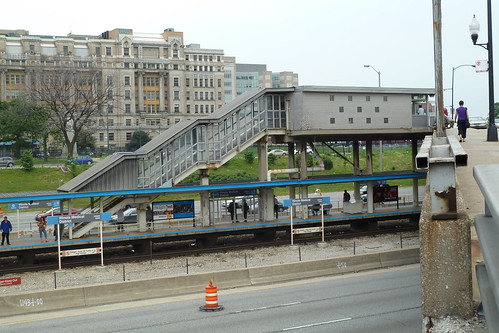Envisioning a More Walkable, Transit-Accessible Illinois Medical Distric
4:51 PM CST on February 18, 2014
With 560 acres of medical research facilities, labs, and classrooms, and more than 40 healthcare facilities, visited by some 50,000 people per day, the Illinois Medical District is a major economic engine. People need convenient access to the campus and to get around within it. With this in mind, a volunteer thinktank submitted a master plan for the district to the IMD leadership, with several ideas to improve transportation options. Last month, the IMD voted to incorporate the ideas into its official master plan.
The plan was brainstormed during a two-day charette hosted last in November by the Chicago Central Area Committee, a braintrust comprised of volunteers from the fields of planning, real estate, and law, as well as the heads of corporations and cultural institutions. In the past, the committee has provided input that helped shape the Museum Campus, Navy Pier and Millennium Park. I recently talked to Mike Szkatulski, managing director of the project management and real estate consulting firm RMC International, who co-chaired the IMD planning session, to learn about their suggestions for improving transportation at the medical district.
One of the key recommendations was to create an intra-district bus service to tie together different parts of the medical campus. “The IMD is really too big to be easily walkable,” Szkatulski said. “We want to connect different parts of the district to each other, to UIC, and to a development being built north of the Eisenhower. That seemed like an obvious missing piece.”
There are plans in the works to enhance the pedestrian environment at the Peoria entrance of the UIC-Halsted Blue Line stop, about a mile east of the IMD, by building a cul-de-sac on Peoria north of the station, and and moving the station house to create a car-free plaza. The pedestrian bridge over the Ike at this location will also be rebuilt and new fencing and landscaping will be added. The CCAC wants to see comparable improvements to the walking environment at the Blue Line’s Illinois Medical District stop, which is already slated for a $23 million rehab next year to make all three entrances accessible to people with disabilities.
“We were thinking a similar treatment could be done at the Ogden entrance, which currently brings you up to a narrow sidewalk on a major street,” Szkatulski said. “That location is the front door of the whole medical district.” The CCAC plan calls for significantly widening the east sidewalk of Ogden where it crosses the Ike, to create a more inviting walking route to the campus, as well as adding a gateway sign over the expressway.
The plan recommends rethinking the way parking is handled on the medical campus. “It isn’t coordinated,” Szkatulski said. “The major stakeholders are dealing with the issue independently. They really need to come up with a plan for the whole IMD.” He notes that the area is about to become denser, with several new developments in the works. For example, the IMD leadership has a request for proposals out, asking for ideas to develop about ten acres of parking lots on the west side of the campus into office space, labs, residential units, retail, and/or hotels. One idea for accommodating future parking demand without building new lots is to work out an arrangement with the operators of lots that serve United Center customers, with shuttle bus service to the campus.
Another way to address the parking issue is to provide more alternatives to driving, which is why the IMD commission has signed on as an official supporter of the plan for Ashland bus rapid transit, which will run down the eastern border of the campus. “In the plan, we acknowledged that BRT would come down the side of the whole district, so that's something the IMD will have to work with and take advantage of,” Szkatuski said.
However, the charette took place on the eve of the December public input hearings on the BRT plan, when opponents were getting plenty of airtime in the local press. Szkatulski says there wasn’t much discussion for or against BRT at the seminar. “There was so much going on with the meetings, there wasn’t much we could say until it was sorted out,” he said.
The commission also recommended a few other modest steps for improving conditions for walking and bicycling, including well-lit, well-landscaped walking paths with good wayfinding signs, plus on-street bicycle lanes, bike racks and Divvy stations. "Different transportation modes need to be incorporated into the streetscape," Szkatulski said.
The IMD leadership is currently looking into hiring an urban planning company to create an official master plan for the district, incorporating some of the suggestions put forth in the CCAC's plan.
In addition to editing Streetsblog Chicago, John writes about transportation and other topics for additional local publications. A Chicagoan since 1989, he enjoys exploring the city on foot, bike, bus, and 'L' train.
Stay in touch
Sign up for our free newsletter
More from Streetsblog Chicago
Today’s Headlines for Thursday, April 25
It’s electric! New Divvy stations will be able to charge docked e-bikes, scooters when they’re connected to the power grid
The new stations are supposed to be easier to use and more environmentally friendly than old-school stations.




